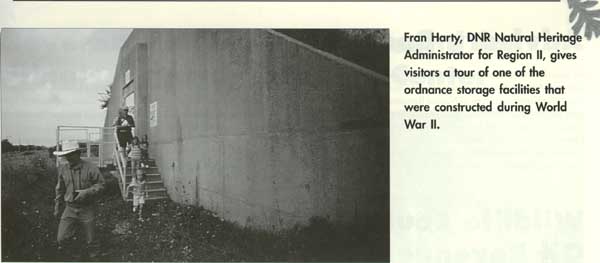

|
While protecting what's there and restoring what isn't are top priorities, Midewin will also offer educational and recreational opportunities. Hunting has been offered in the past at the arsenal, and that will continue, Harty said. As for fishing, he said, "We're trying to figure out how you let thousands of people fish in the three little streams and still have any fish. These are the gatmuts: it could he no fishing; it could be fly fishing for kids only since they don't have the skills to catch as many fish; or it could be strictly catch-and-release. On federal lands they don't normally do the put-and-take scenario." Other forms of recreation being considered include hiking, biking and horse trails, camping and picnicking. These will probably be phased-in gradually over a number of years as funding becomes available, Harty said. Recreational activities would be limited to certain areas or open seasonally so as not to disturb habitats of endangered species or allow the public to interact with bison or elk. Also receiving major consideration is a bus or tram system that would ferry riders from a proposed visitors center to wildlife viewing areas or recreation areas throughout the site. "Don't forget that we're within 40 miles of 10 million people," Harry said. "I think everybody's familiar with the problems they're having at Yosemite and Yellowstone parks. Where do you put all those people and their cars? One solution is to have a big parking lot. People leave their cars, are orientated at the visitors center and get on a tram." |
A tram would provide three benefits for site managers, Harry said. It would allow the public to visit areas where endangered species or bison and/or elk are located without actually interacting with them; aged or disabled individuals would have easier access; and interpretive educational opportunities would be provided. Harry was careful to point out that Midewin is still very much in the planning stages and that the final plan won't be completed until August 1999 at the earliest. This past summer, five open house meetings were held in various communities throughout northeastern Illinois. Following analysis of comments made at those meetings, public workshops to consider alternative proposals will be scheduled later this fall. A draft environmental impact statement is scheduled for publication in February, followed by a 90-day public comment period and more open house meetings. "Wide-open public access will probably take 10 years," Harry said. "What we're striving for now is limited access. In the meantime, we're doing tours." The free tours last about two hours and are limited to 25 people. Reservations are required and can be made by calling (815)423-6370, extension 14. JOHN ALLEN |